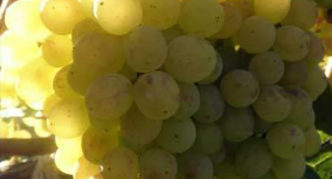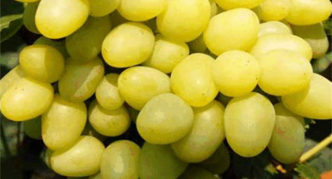New grape varieties bred by professional breeders are not presented to the general public very often, because variety testing is a long process. On the other hand, new products that appear often best meet the needs of winegrowers from different regions. One of them is the Harold grape.
The size of the bunch is not always important
The Novocherkassk VNIIVmV named after Potapenko is one of the most authoritative domestic institutions in the field of viticulture. It was his employees who created the hybrid form Harold, which, as soon as it appeared, very quickly spread in many regions of the country.
Harold was born on a long road. First, a hybrid of the varieties Vostorg and Arcadia was obtained, which was later crossed with Summer Muscat. The result, which during the period of work was called IV-6-5-pc, turned out not only satisfactory, but excellent.
Harold's genetic ancestors - photo gallery
- The Delight variety was used to create the hybrid form Harold
- The Arcadia variety was used to create the Harold grape
- Summer Muscat was used to create the Harold grape
The first, and for winegrowers in the northern regions, perhaps the most important characteristic of this form is the very short ripening period of the crop, which takes no more than 100 days. This grape, of course, is grown in the southern regions, only there it is cultivated in an uncovered form. The exact index of frost resistance of the form is still under study, but gardeners note that it has a value of at least -25 ºС. For southerners, Harold may be interested in the possibility of obtaining a second harvest - in the autumn, ripening on stepchildren.
It is important, of course, that Harold grapes belong to the category of canteens with an excellent nutmeg taste. And although some growers lament that Harold's bunches are small, rarely which of them weighs more than 500 grams, this is completely covered by the merits of the grapes. It is not only consistently yielded, but is so inclined to overload itself with bunches that rationing of shoots and inflorescences is an indispensable condition for its cultivation.
By the way, there are no peculiarities of planting or agriculture of these grapes. On the contrary, it easily tolerates both drying of the soil and some waterlogging, which for many other grape varieties is an extremely negative factor.
Few details about Harold
Bushes of the hybrid form Harold are massive, have great vigor and shoots ripening along the entire length. 75–80% of young branches this year are fruitful, each of them has about one and a half brushes.

Perhaps the most important characteristic of this form is the very short ripening period of the crop, taking no more than 100 days.
The geometric outlines of the bunches are close to the cylinder. The berries in the brushes are densely packed, sometimes slightly looser. In shape, rather large oval grapes 2.4x2 cm, and weigh 5-7 grams. The color of the unripe berries is white, by the time of full ripening it turns yellow, like amber.
The fleshy, juicy interior of the berries is quite dense, as is the skin that covers it. Harold grapes contain up to 20% sugar and 5 g of acid per liter of juice. For the entire period of cultivation of this form, peas were not observed. In any weather, the berries remain intact, do not crack.
The transportation of the crop does not affect the quality of the bunches and berries in any way.
Harold grapes have good immunity to infection with gray mold and powdery mildew (resistance to mildew at the level of 3 points, oidimum - 3.5). In addition, he is not afraid of either ticks or wasps.
What's on the reverse of the medal
According to the available descriptions, Harold's hybrid form consists of solid merits, but, probably, this medal also has a downside. This can only be judged by comparing it with similar varieties. Let's take, for example, Lark and Superearly Red Muscat, similar to Harold in terms of the presence of nutmeg aroma and ripening period.
Table: characteristics of the Harold variety in comparison with similar varieties
| Parameter | Harold | Lark | Very early red nutmeg |
| Ripening period | 95-100 days | 95-100 days | 95-100 days |
| Growth strength of bushes | vigorous | medium or higher | medium-sized |
| Bunch weight (average) | 450-500 g | 400-500 g | 600 g |
| Berry weight (average) | 5-6 g | 5–6 | 5 |
| Sugar content | 19–20% | 19–20% | 15–20% |
| Acid in a liter of juice | 4-5 g | 5-6 g | 5–7 |
| Ripening shoots | good | excellent | not bad |
| The need for rationing | Yes | not | not |
| Winter hardiness | -25 ºС | -23 ºС | -23 ºС |
| The number of fruitful shoots | 75–80% | 60–75% | 65% |
| Disease resistance | resistant to gray rot, mildew 3 points, oidimum 3.5 points, | increased resistance to mildew and powdery mildew | very resistant to mildew, mildew and gray rot |
| Transportability | Yes | Yes | Yes |
Of course, this is not a scientific study, but information collected on the Internet, but the data provided shows that Harold is practically in no way inferior to similar grapes. If there are differences in the characteristics of these grapes, then they are not fundamental.
Video about grape Harold
Winegrowers' reviews of the hybrid form Harold
I have heard a lot of good things about this variety. Therefore, when it suddenly loomed on the horizon, I did not doubt the wisdom of purchasing it. The year was generous with an abundance of warm, sunny days and the grapes began to ripen earlier than usual. We tasted Harold on July 17th, almost a week earlier than our closest pursuers. I was struck by everything and the taste, and the look and resistance to all kinds of non-trivialities. The berry is white, oval. The size is not the largest, but very decent for the very early grapes. . The taste is good nutmeg, which lasts regardless of the weather. We picked the last bunches in the middle of September, the taste was excellent. The bunches were up to half a kilogram, of an excellent look. It is also important that no defects were noticed either in the green or in the mature state. The bunches did not need to be plucked, given a presentation, there was no need for this.
Very early ripening. I want to note - a very successful form. This year has matured a little earlier than the Anniversary of the Kherson summer resident. The pulp is dense, resistant to cracking, disease. Berry with a pleasant nutmeg aroma, rather tender than strong. Does not peel, does not crack after rains. I picked up sugar well - it was not yet quite ripe, it was already sweet, edible. Under the conditions of Volgograd, it ripens approximately on July 15–20.
The hybrid form of Harold grapes in all its characteristics is quite suitable for cultivation in summer cottages and backyards in regions with different climates.





